Critical Assessment of Microsoft's Business Strategy and Organization
VerifiedAdded on 2023/06/12
|19
|4644
|124
Report
AI Summary
This report provides an in-depth analysis of Microsoft's generic business strategies, organizational culture, and formal organizational structure. It identifies the integrated strategies Microsoft uses to gain a competitive edge, focusing on broad differentiation and cost leadership. The report also examines how Microsoft's organizational culture, characterized by accountability, innovation, quality, and customer responsiveness, supports its strategic objectives. Furthermore, the formal organizational structure, including its various divisions and their functions, is analyzed to understand its impact on the company's culture and overall performance. The report concludes by emphasizing the interconnectedness of these three organizational aspects in driving Microsoft's success in the technology industry. Desklib provides students with access to similar solved assignments and past papers to aid in their studies.
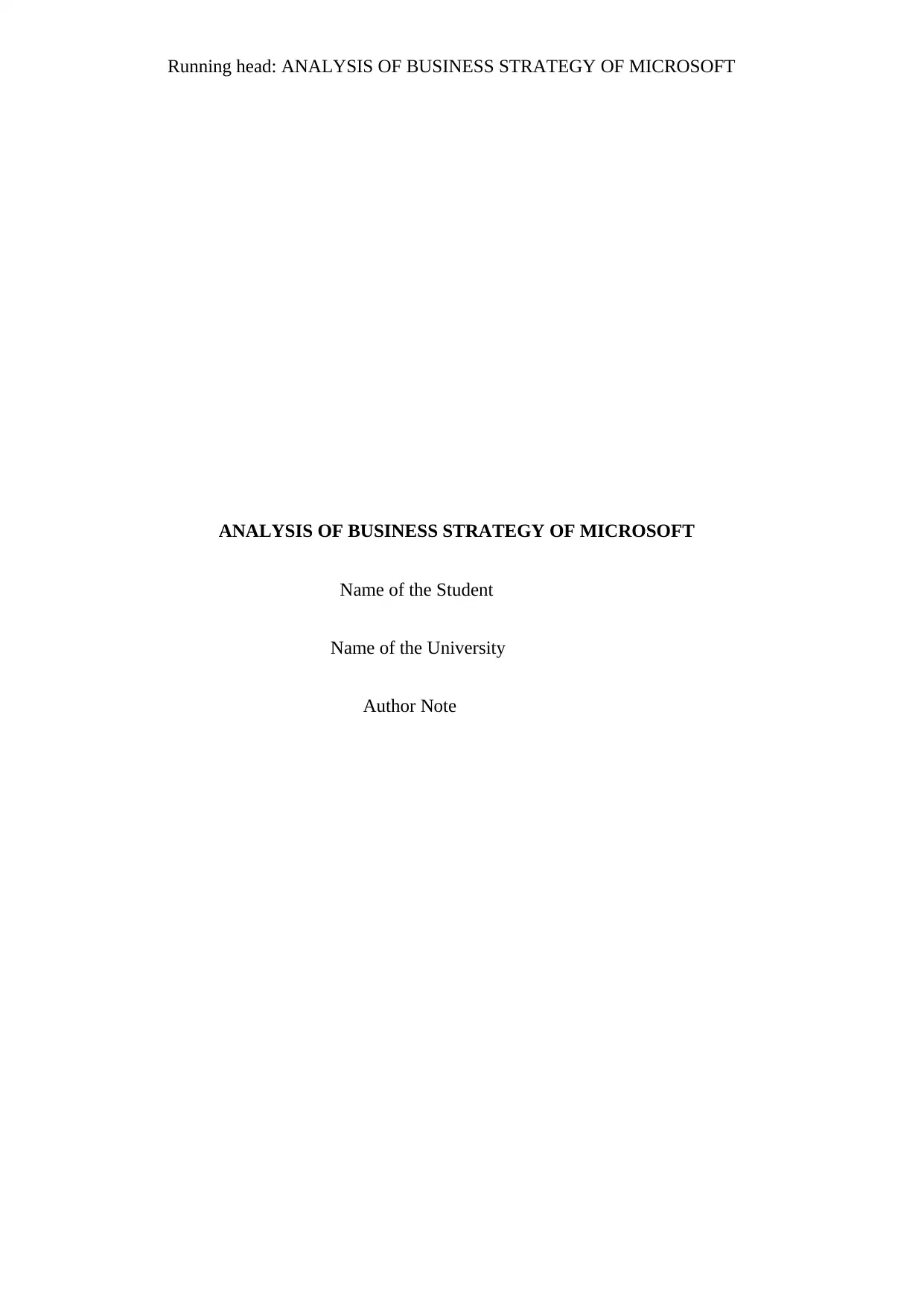
Running head: ANALYSIS OF BUSINESS STRATEGY OF MICROSOFT
ANALYSIS OF BUSINESS STRATEGY OF MICROSOFT
Name of the Student
Name of the University
Author Note
ANALYSIS OF BUSINESS STRATEGY OF MICROSOFT
Name of the Student
Name of the University
Author Note
Paraphrase This Document
Need a fresh take? Get an instant paraphrase of this document with our AI Paraphraser
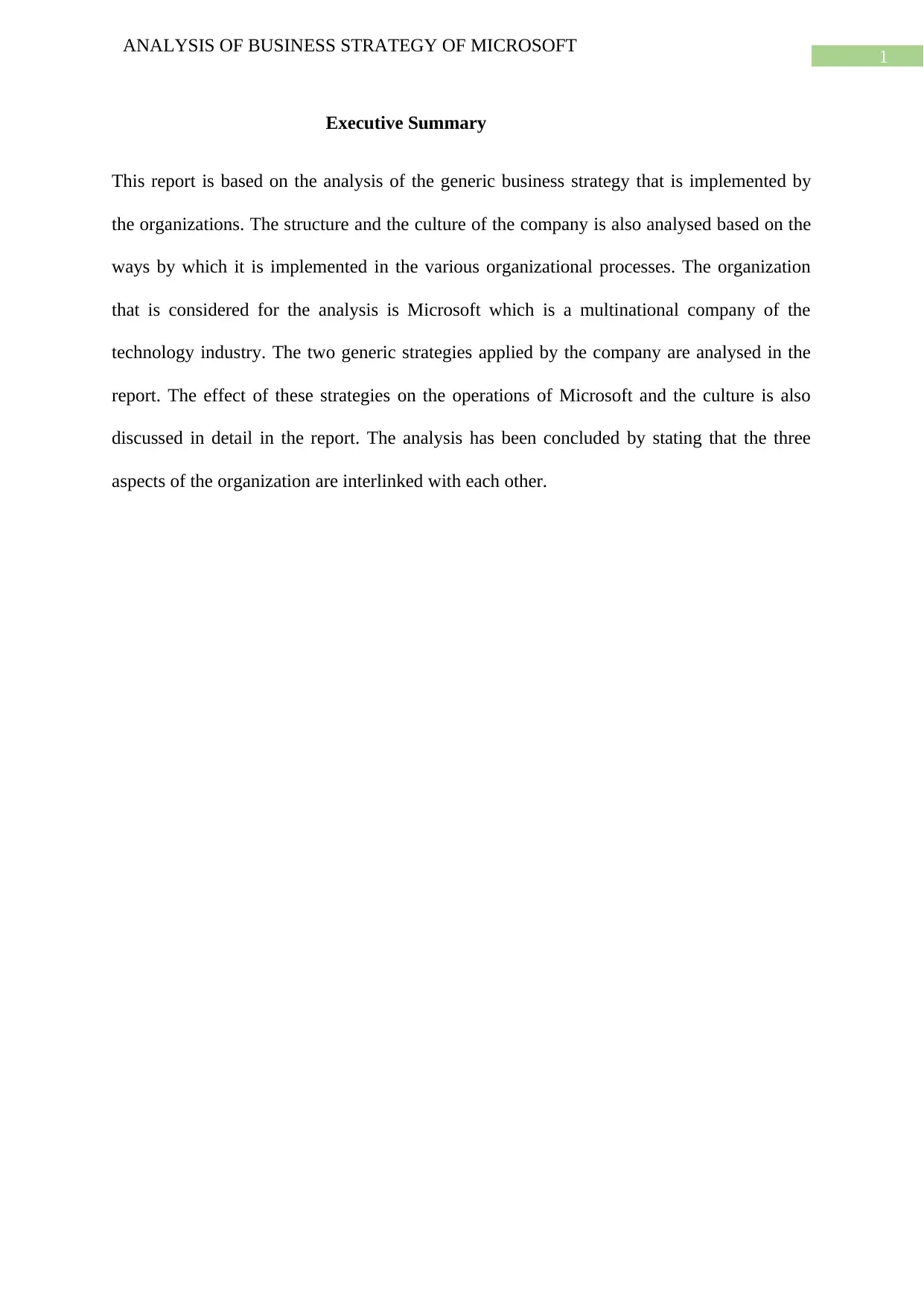
1
ANALYSIS OF BUSINESS STRATEGY OF MICROSOFT
Executive Summary
This report is based on the analysis of the generic business strategy that is implemented by
the organizations. The structure and the culture of the company is also analysed based on the
ways by which it is implemented in the various organizational processes. The organization
that is considered for the analysis is Microsoft which is a multinational company of the
technology industry. The two generic strategies applied by the company are analysed in the
report. The effect of these strategies on the operations of Microsoft and the culture is also
discussed in detail in the report. The analysis has been concluded by stating that the three
aspects of the organization are interlinked with each other.
ANALYSIS OF BUSINESS STRATEGY OF MICROSOFT
Executive Summary
This report is based on the analysis of the generic business strategy that is implemented by
the organizations. The structure and the culture of the company is also analysed based on the
ways by which it is implemented in the various organizational processes. The organization
that is considered for the analysis is Microsoft which is a multinational company of the
technology industry. The two generic strategies applied by the company are analysed in the
report. The effect of these strategies on the operations of Microsoft and the culture is also
discussed in detail in the report. The analysis has been concluded by stating that the three
aspects of the organization are interlinked with each other.
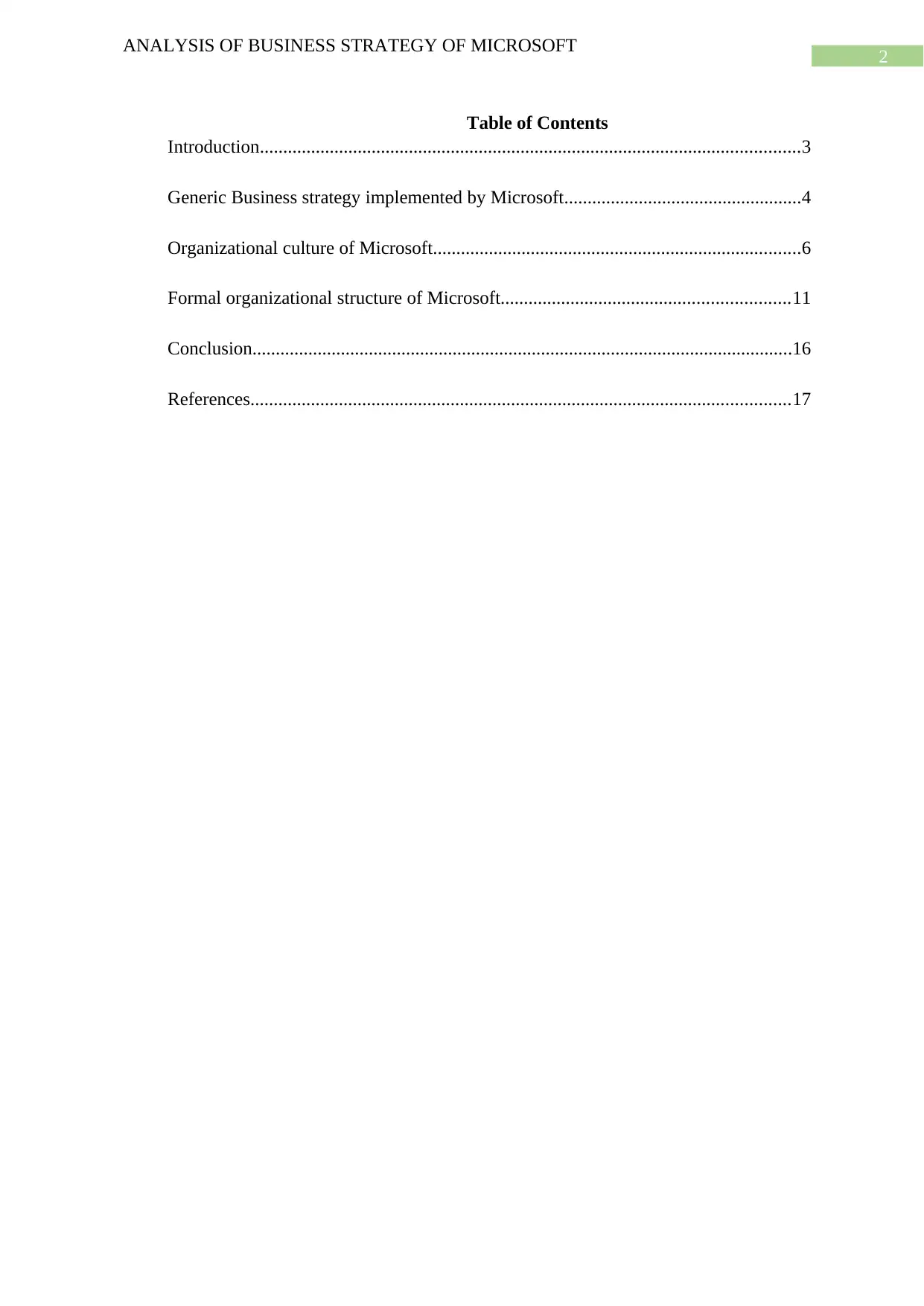
2
ANALYSIS OF BUSINESS STRATEGY OF MICROSOFT
Table of Contents
Introduction....................................................................................................................3
Generic Business strategy implemented by Microsoft...................................................4
Organizational culture of Microsoft...............................................................................6
Formal organizational structure of Microsoft..............................................................11
Conclusion....................................................................................................................16
References....................................................................................................................17
ANALYSIS OF BUSINESS STRATEGY OF MICROSOFT
Table of Contents
Introduction....................................................................................................................3
Generic Business strategy implemented by Microsoft...................................................4
Organizational culture of Microsoft...............................................................................6
Formal organizational structure of Microsoft..............................................................11
Conclusion....................................................................................................................16
References....................................................................................................................17
⊘ This is a preview!⊘
Do you want full access?
Subscribe today to unlock all pages.

Trusted by 1+ million students worldwide
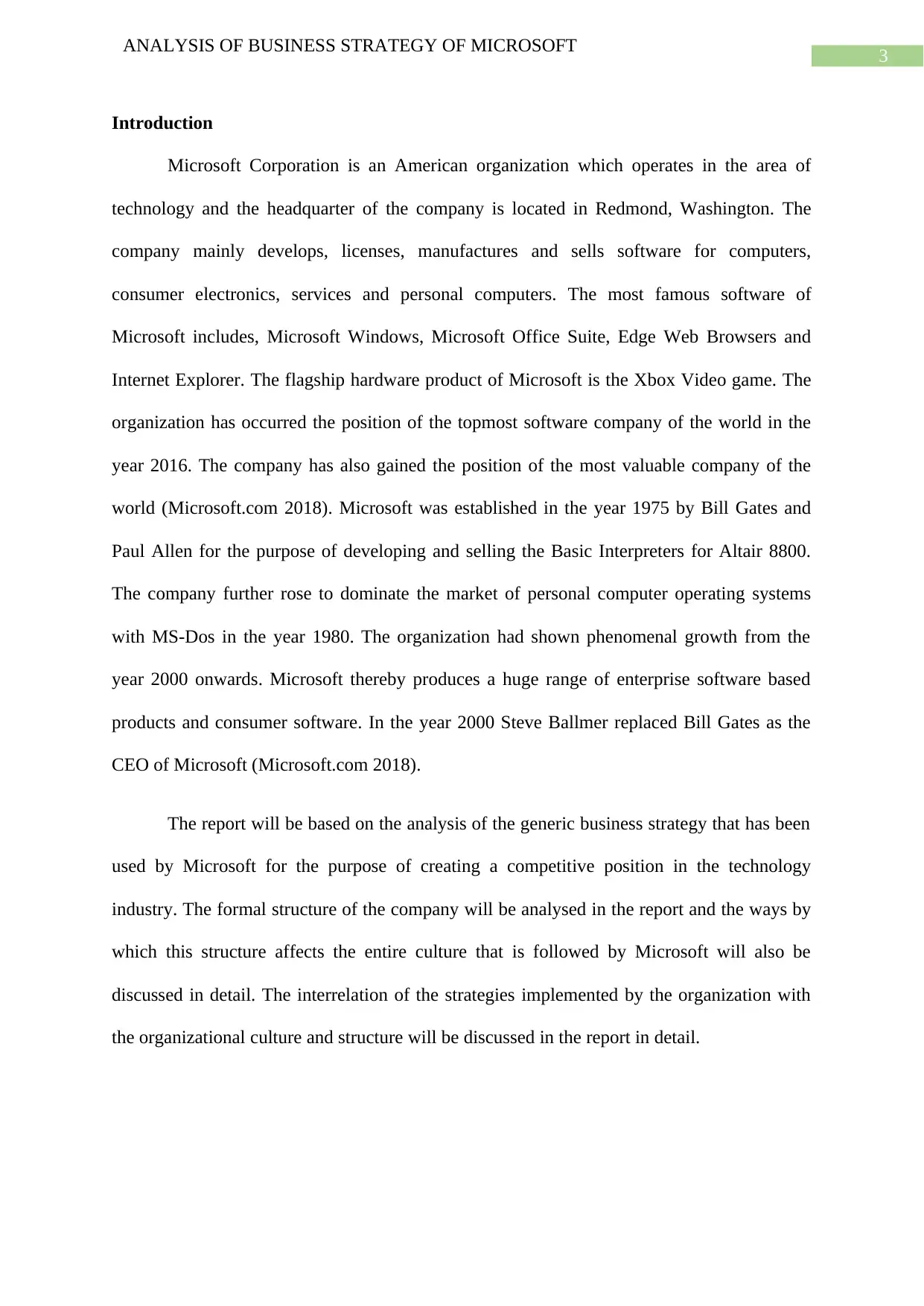
3
ANALYSIS OF BUSINESS STRATEGY OF MICROSOFT
Introduction
Microsoft Corporation is an American organization which operates in the area of
technology and the headquarter of the company is located in Redmond, Washington. The
company mainly develops, licenses, manufactures and sells software for computers,
consumer electronics, services and personal computers. The most famous software of
Microsoft includes, Microsoft Windows, Microsoft Office Suite, Edge Web Browsers and
Internet Explorer. The flagship hardware product of Microsoft is the Xbox Video game. The
organization has occurred the position of the topmost software company of the world in the
year 2016. The company has also gained the position of the most valuable company of the
world (Microsoft.com 2018). Microsoft was established in the year 1975 by Bill Gates and
Paul Allen for the purpose of developing and selling the Basic Interpreters for Altair 8800.
The company further rose to dominate the market of personal computer operating systems
with MS-Dos in the year 1980. The organization had shown phenomenal growth from the
year 2000 onwards. Microsoft thereby produces a huge range of enterprise software based
products and consumer software. In the year 2000 Steve Ballmer replaced Bill Gates as the
CEO of Microsoft (Microsoft.com 2018).
The report will be based on the analysis of the generic business strategy that has been
used by Microsoft for the purpose of creating a competitive position in the technology
industry. The formal structure of the company will be analysed in the report and the ways by
which this structure affects the entire culture that is followed by Microsoft will also be
discussed in detail. The interrelation of the strategies implemented by the organization with
the organizational culture and structure will be discussed in the report in detail.
ANALYSIS OF BUSINESS STRATEGY OF MICROSOFT
Introduction
Microsoft Corporation is an American organization which operates in the area of
technology and the headquarter of the company is located in Redmond, Washington. The
company mainly develops, licenses, manufactures and sells software for computers,
consumer electronics, services and personal computers. The most famous software of
Microsoft includes, Microsoft Windows, Microsoft Office Suite, Edge Web Browsers and
Internet Explorer. The flagship hardware product of Microsoft is the Xbox Video game. The
organization has occurred the position of the topmost software company of the world in the
year 2016. The company has also gained the position of the most valuable company of the
world (Microsoft.com 2018). Microsoft was established in the year 1975 by Bill Gates and
Paul Allen for the purpose of developing and selling the Basic Interpreters for Altair 8800.
The company further rose to dominate the market of personal computer operating systems
with MS-Dos in the year 1980. The organization had shown phenomenal growth from the
year 2000 onwards. Microsoft thereby produces a huge range of enterprise software based
products and consumer software. In the year 2000 Steve Ballmer replaced Bill Gates as the
CEO of Microsoft (Microsoft.com 2018).
The report will be based on the analysis of the generic business strategy that has been
used by Microsoft for the purpose of creating a competitive position in the technology
industry. The formal structure of the company will be analysed in the report and the ways by
which this structure affects the entire culture that is followed by Microsoft will also be
discussed in detail. The interrelation of the strategies implemented by the organization with
the organizational culture and structure will be discussed in the report in detail.
Paraphrase This Document
Need a fresh take? Get an instant paraphrase of this document with our AI Paraphraser
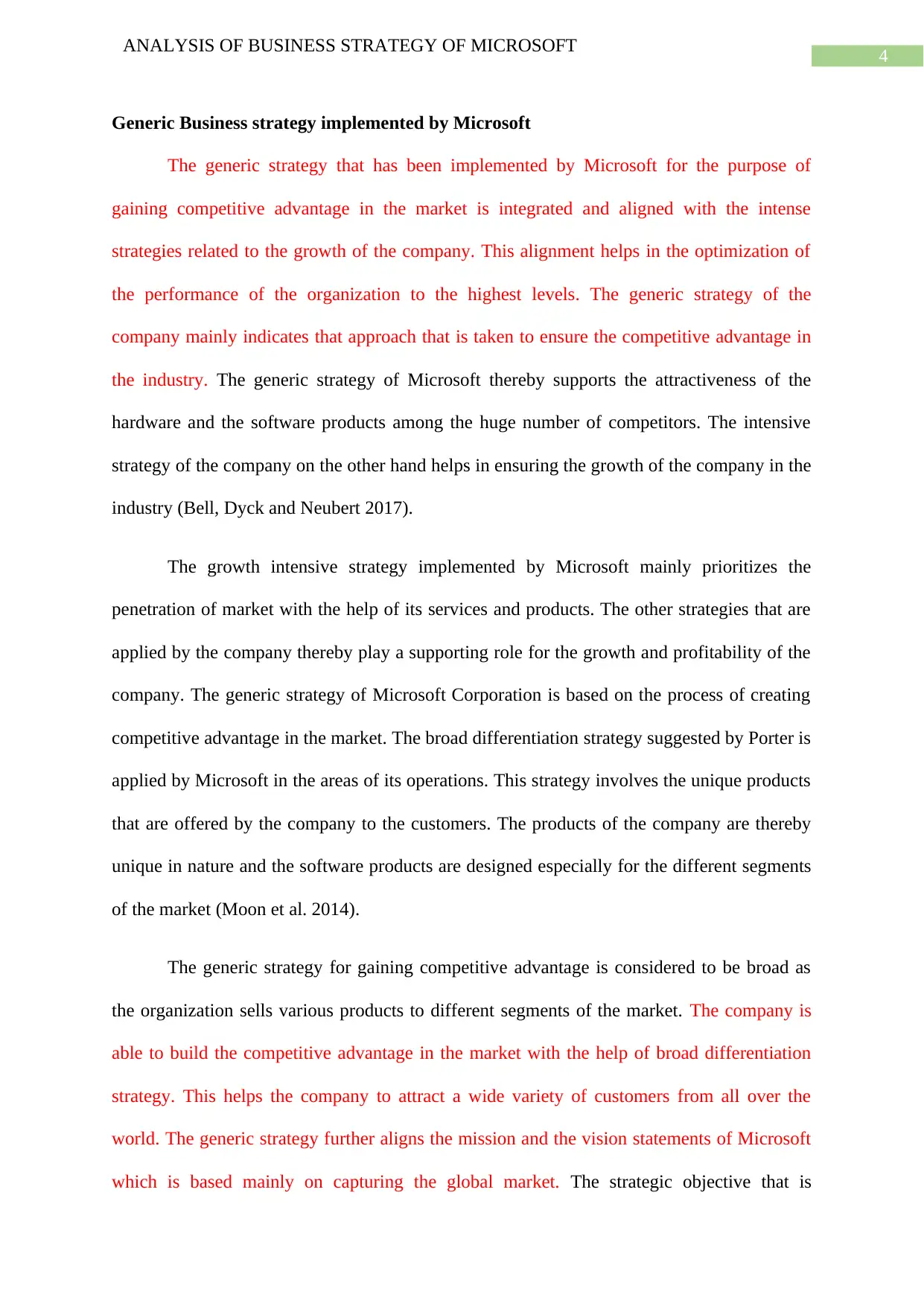
4
ANALYSIS OF BUSINESS STRATEGY OF MICROSOFT
Generic Business strategy implemented by Microsoft
The generic strategy that has been implemented by Microsoft for the purpose of
gaining competitive advantage in the market is integrated and aligned with the intense
strategies related to the growth of the company. This alignment helps in the optimization of
the performance of the organization to the highest levels. The generic strategy of the
company mainly indicates that approach that is taken to ensure the competitive advantage in
the industry. The generic strategy of Microsoft thereby supports the attractiveness of the
hardware and the software products among the huge number of competitors. The intensive
strategy of the company on the other hand helps in ensuring the growth of the company in the
industry (Bell, Dyck and Neubert 2017).
The growth intensive strategy implemented by Microsoft mainly prioritizes the
penetration of market with the help of its services and products. The other strategies that are
applied by the company thereby play a supporting role for the growth and profitability of the
company. The generic strategy of Microsoft Corporation is based on the process of creating
competitive advantage in the market. The broad differentiation strategy suggested by Porter is
applied by Microsoft in the areas of its operations. This strategy involves the unique products
that are offered by the company to the customers. The products of the company are thereby
unique in nature and the software products are designed especially for the different segments
of the market (Moon et al. 2014).
The generic strategy for gaining competitive advantage is considered to be broad as
the organization sells various products to different segments of the market. The company is
able to build the competitive advantage in the market with the help of broad differentiation
strategy. This helps the company to attract a wide variety of customers from all over the
world. The generic strategy further aligns the mission and the vision statements of Microsoft
which is based mainly on capturing the global market. The strategic objective that is
ANALYSIS OF BUSINESS STRATEGY OF MICROSOFT
Generic Business strategy implemented by Microsoft
The generic strategy that has been implemented by Microsoft for the purpose of
gaining competitive advantage in the market is integrated and aligned with the intense
strategies related to the growth of the company. This alignment helps in the optimization of
the performance of the organization to the highest levels. The generic strategy of the
company mainly indicates that approach that is taken to ensure the competitive advantage in
the industry. The generic strategy of Microsoft thereby supports the attractiveness of the
hardware and the software products among the huge number of competitors. The intensive
strategy of the company on the other hand helps in ensuring the growth of the company in the
industry (Bell, Dyck and Neubert 2017).
The growth intensive strategy implemented by Microsoft mainly prioritizes the
penetration of market with the help of its services and products. The other strategies that are
applied by the company thereby play a supporting role for the growth and profitability of the
company. The generic strategy of Microsoft Corporation is based on the process of creating
competitive advantage in the market. The broad differentiation strategy suggested by Porter is
applied by Microsoft in the areas of its operations. This strategy involves the unique products
that are offered by the company to the customers. The products of the company are thereby
unique in nature and the software products are designed especially for the different segments
of the market (Moon et al. 2014).
The generic strategy for gaining competitive advantage is considered to be broad as
the organization sells various products to different segments of the market. The company is
able to build the competitive advantage in the market with the help of broad differentiation
strategy. This helps the company to attract a wide variety of customers from all over the
world. The generic strategy further aligns the mission and the vision statements of Microsoft
which is based mainly on capturing the global market. The strategic objective that is
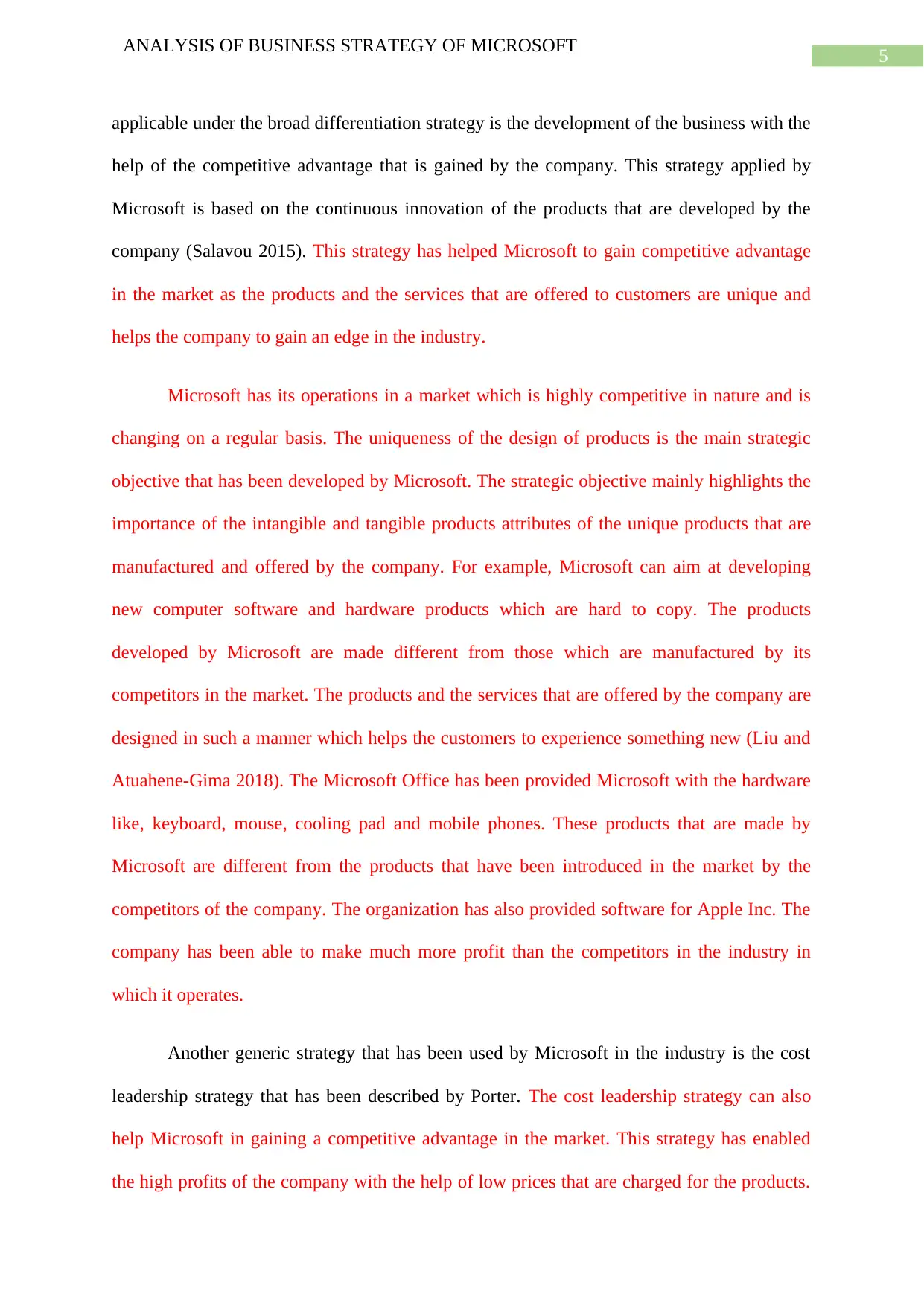
5
ANALYSIS OF BUSINESS STRATEGY OF MICROSOFT
applicable under the broad differentiation strategy is the development of the business with the
help of the competitive advantage that is gained by the company. This strategy applied by
Microsoft is based on the continuous innovation of the products that are developed by the
company (Salavou 2015). This strategy has helped Microsoft to gain competitive advantage
in the market as the products and the services that are offered to customers are unique and
helps the company to gain an edge in the industry.
Microsoft has its operations in a market which is highly competitive in nature and is
changing on a regular basis. The uniqueness of the design of products is the main strategic
objective that has been developed by Microsoft. The strategic objective mainly highlights the
importance of the intangible and tangible products attributes of the unique products that are
manufactured and offered by the company. For example, Microsoft can aim at developing
new computer software and hardware products which are hard to copy. The products
developed by Microsoft are made different from those which are manufactured by its
competitors in the market. The products and the services that are offered by the company are
designed in such a manner which helps the customers to experience something new (Liu and
Atuahene-Gima 2018). The Microsoft Office has been provided Microsoft with the hardware
like, keyboard, mouse, cooling pad and mobile phones. These products that are made by
Microsoft are different from the products that have been introduced in the market by the
competitors of the company. The organization has also provided software for Apple Inc. The
company has been able to make much more profit than the competitors in the industry in
which it operates.
Another generic strategy that has been used by Microsoft in the industry is the cost
leadership strategy that has been described by Porter. The cost leadership strategy can also
help Microsoft in gaining a competitive advantage in the market. This strategy has enabled
the high profits of the company with the help of low prices that are charged for the products.
ANALYSIS OF BUSINESS STRATEGY OF MICROSOFT
applicable under the broad differentiation strategy is the development of the business with the
help of the competitive advantage that is gained by the company. This strategy applied by
Microsoft is based on the continuous innovation of the products that are developed by the
company (Salavou 2015). This strategy has helped Microsoft to gain competitive advantage
in the market as the products and the services that are offered to customers are unique and
helps the company to gain an edge in the industry.
Microsoft has its operations in a market which is highly competitive in nature and is
changing on a regular basis. The uniqueness of the design of products is the main strategic
objective that has been developed by Microsoft. The strategic objective mainly highlights the
importance of the intangible and tangible products attributes of the unique products that are
manufactured and offered by the company. For example, Microsoft can aim at developing
new computer software and hardware products which are hard to copy. The products
developed by Microsoft are made different from those which are manufactured by its
competitors in the market. The products and the services that are offered by the company are
designed in such a manner which helps the customers to experience something new (Liu and
Atuahene-Gima 2018). The Microsoft Office has been provided Microsoft with the hardware
like, keyboard, mouse, cooling pad and mobile phones. These products that are made by
Microsoft are different from the products that have been introduced in the market by the
competitors of the company. The organization has also provided software for Apple Inc. The
company has been able to make much more profit than the competitors in the industry in
which it operates.
Another generic strategy that has been used by Microsoft in the industry is the cost
leadership strategy that has been described by Porter. The cost leadership strategy can also
help Microsoft in gaining a competitive advantage in the market. This strategy has enabled
the high profits of the company with the help of low prices that are charged for the products.
⊘ This is a preview!⊘
Do you want full access?
Subscribe today to unlock all pages.

Trusted by 1+ million students worldwide
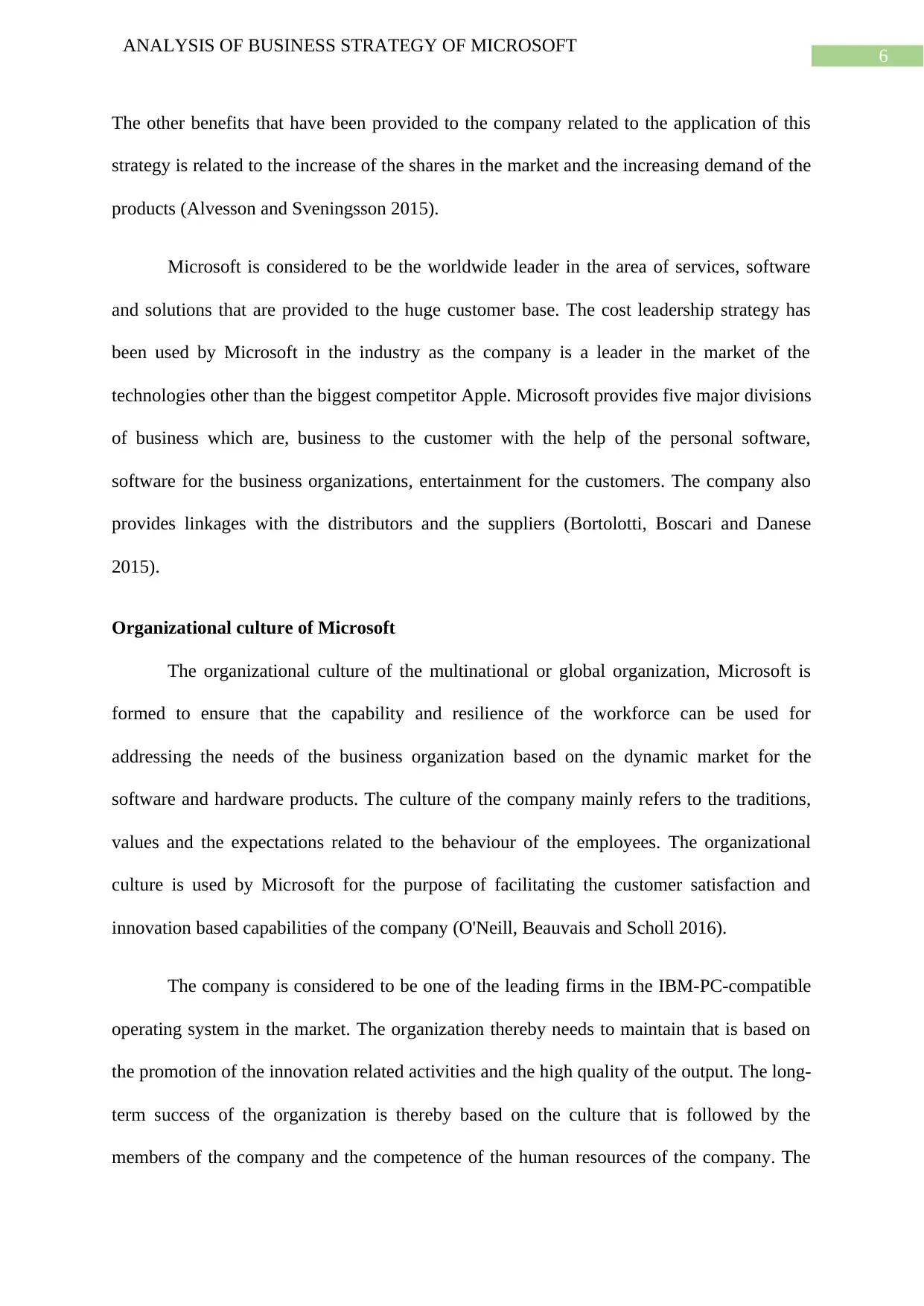
6
ANALYSIS OF BUSINESS STRATEGY OF MICROSOFT
The other benefits that have been provided to the company related to the application of this
strategy is related to the increase of the shares in the market and the increasing demand of the
products (Alvesson and Sveningsson 2015).
Microsoft is considered to be the worldwide leader in the area of services, software
and solutions that are provided to the huge customer base. The cost leadership strategy has
been used by Microsoft in the industry as the company is a leader in the market of the
technologies other than the biggest competitor Apple. Microsoft provides five major divisions
of business which are, business to the customer with the help of the personal software,
software for the business organizations, entertainment for the customers. The company also
provides linkages with the distributors and the suppliers (Bortolotti, Boscari and Danese
2015).
Organizational culture of Microsoft
The organizational culture of the multinational or global organization, Microsoft is
formed to ensure that the capability and resilience of the workforce can be used for
addressing the needs of the business organization based on the dynamic market for the
software and hardware products. The culture of the company mainly refers to the traditions,
values and the expectations related to the behaviour of the employees. The organizational
culture is used by Microsoft for the purpose of facilitating the customer satisfaction and
innovation based capabilities of the company (O'Neill, Beauvais and Scholl 2016).
The company is considered to be one of the leading firms in the IBM-PC-compatible
operating system in the market. The organization thereby needs to maintain that is based on
the promotion of the innovation related activities and the high quality of the output. The long-
term success of the organization is thereby based on the culture that is followed by the
members of the company and the competence of the human resources of the company. The
ANALYSIS OF BUSINESS STRATEGY OF MICROSOFT
The other benefits that have been provided to the company related to the application of this
strategy is related to the increase of the shares in the market and the increasing demand of the
products (Alvesson and Sveningsson 2015).
Microsoft is considered to be the worldwide leader in the area of services, software
and solutions that are provided to the huge customer base. The cost leadership strategy has
been used by Microsoft in the industry as the company is a leader in the market of the
technologies other than the biggest competitor Apple. Microsoft provides five major divisions
of business which are, business to the customer with the help of the personal software,
software for the business organizations, entertainment for the customers. The company also
provides linkages with the distributors and the suppliers (Bortolotti, Boscari and Danese
2015).
Organizational culture of Microsoft
The organizational culture of the multinational or global organization, Microsoft is
formed to ensure that the capability and resilience of the workforce can be used for
addressing the needs of the business organization based on the dynamic market for the
software and hardware products. The culture of the company mainly refers to the traditions,
values and the expectations related to the behaviour of the employees. The organizational
culture is used by Microsoft for the purpose of facilitating the customer satisfaction and
innovation based capabilities of the company (O'Neill, Beauvais and Scholl 2016).
The company is considered to be one of the leading firms in the IBM-PC-compatible
operating system in the market. The organization thereby needs to maintain that is based on
the promotion of the innovation related activities and the high quality of the output. The long-
term success of the organization is thereby based on the culture that is followed by the
members of the company and the competence of the human resources of the company. The
Paraphrase This Document
Need a fresh take? Get an instant paraphrase of this document with our AI Paraphraser
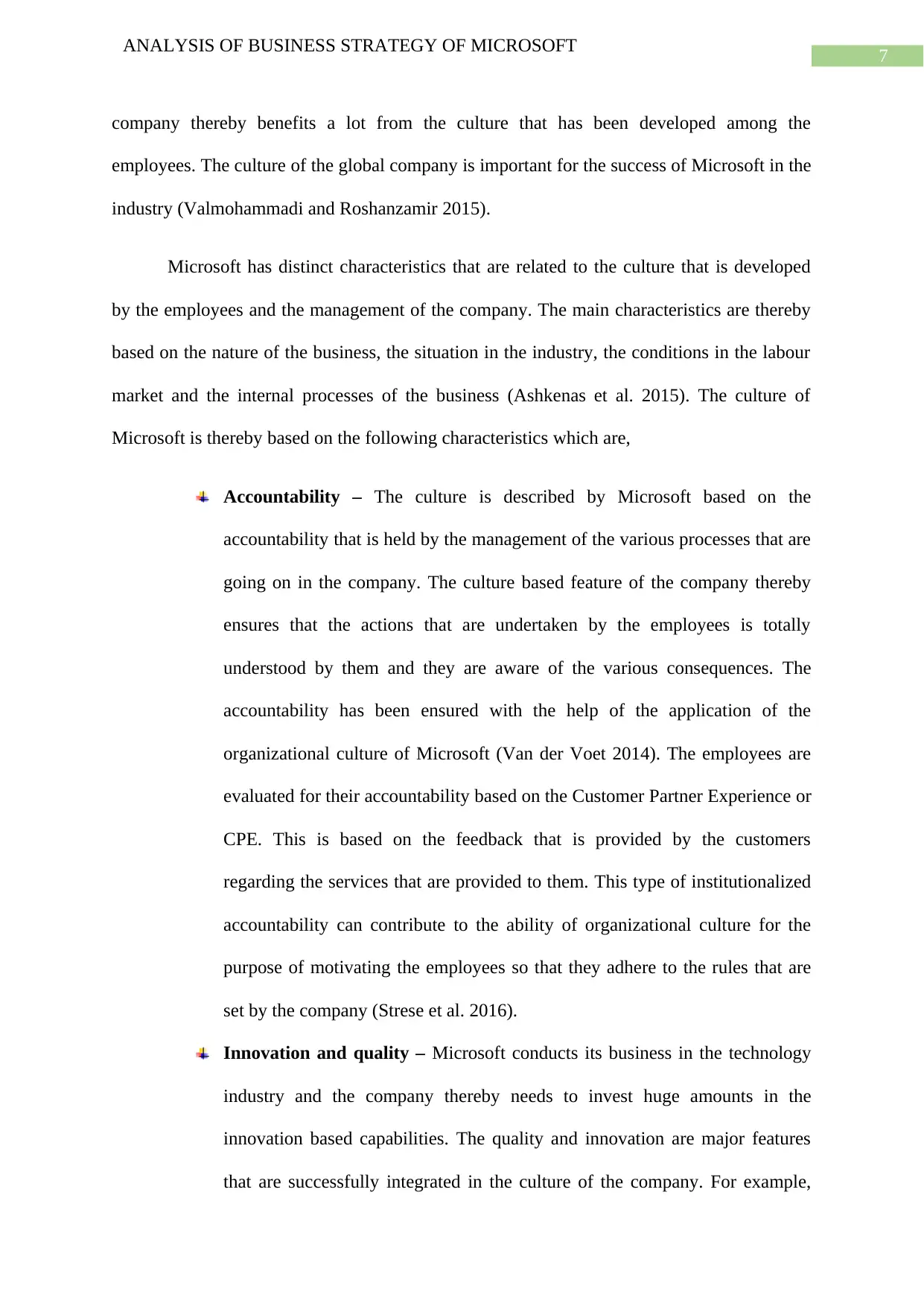
7
ANALYSIS OF BUSINESS STRATEGY OF MICROSOFT
company thereby benefits a lot from the culture that has been developed among the
employees. The culture of the global company is important for the success of Microsoft in the
industry (Valmohammadi and Roshanzamir 2015).
Microsoft has distinct characteristics that are related to the culture that is developed
by the employees and the management of the company. The main characteristics are thereby
based on the nature of the business, the situation in the industry, the conditions in the labour
market and the internal processes of the business (Ashkenas et al. 2015). The culture of
Microsoft is thereby based on the following characteristics which are,
Accountability – The culture is described by Microsoft based on the
accountability that is held by the management of the various processes that are
going on in the company. The culture based feature of the company thereby
ensures that the actions that are undertaken by the employees is totally
understood by them and they are aware of the various consequences. The
accountability has been ensured with the help of the application of the
organizational culture of Microsoft (Van der Voet 2014). The employees are
evaluated for their accountability based on the Customer Partner Experience or
CPE. This is based on the feedback that is provided by the customers
regarding the services that are provided to them. This type of institutionalized
accountability can contribute to the ability of organizational culture for the
purpose of motivating the employees so that they adhere to the rules that are
set by the company (Strese et al. 2016).
Innovation and quality – Microsoft conducts its business in the technology
industry and the company thereby needs to invest huge amounts in the
innovation based capabilities. The quality and innovation are major features
that are successfully integrated in the culture of the company. For example,
ANALYSIS OF BUSINESS STRATEGY OF MICROSOFT
company thereby benefits a lot from the culture that has been developed among the
employees. The culture of the global company is important for the success of Microsoft in the
industry (Valmohammadi and Roshanzamir 2015).
Microsoft has distinct characteristics that are related to the culture that is developed
by the employees and the management of the company. The main characteristics are thereby
based on the nature of the business, the situation in the industry, the conditions in the labour
market and the internal processes of the business (Ashkenas et al. 2015). The culture of
Microsoft is thereby based on the following characteristics which are,
Accountability – The culture is described by Microsoft based on the
accountability that is held by the management of the various processes that are
going on in the company. The culture based feature of the company thereby
ensures that the actions that are undertaken by the employees is totally
understood by them and they are aware of the various consequences. The
accountability has been ensured with the help of the application of the
organizational culture of Microsoft (Van der Voet 2014). The employees are
evaluated for their accountability based on the Customer Partner Experience or
CPE. This is based on the feedback that is provided by the customers
regarding the services that are provided to them. This type of institutionalized
accountability can contribute to the ability of organizational culture for the
purpose of motivating the employees so that they adhere to the rules that are
set by the company (Strese et al. 2016).
Innovation and quality – Microsoft conducts its business in the technology
industry and the company thereby needs to invest huge amounts in the
innovation based capabilities. The quality and innovation are major features
that are successfully integrated in the culture of the company. For example,
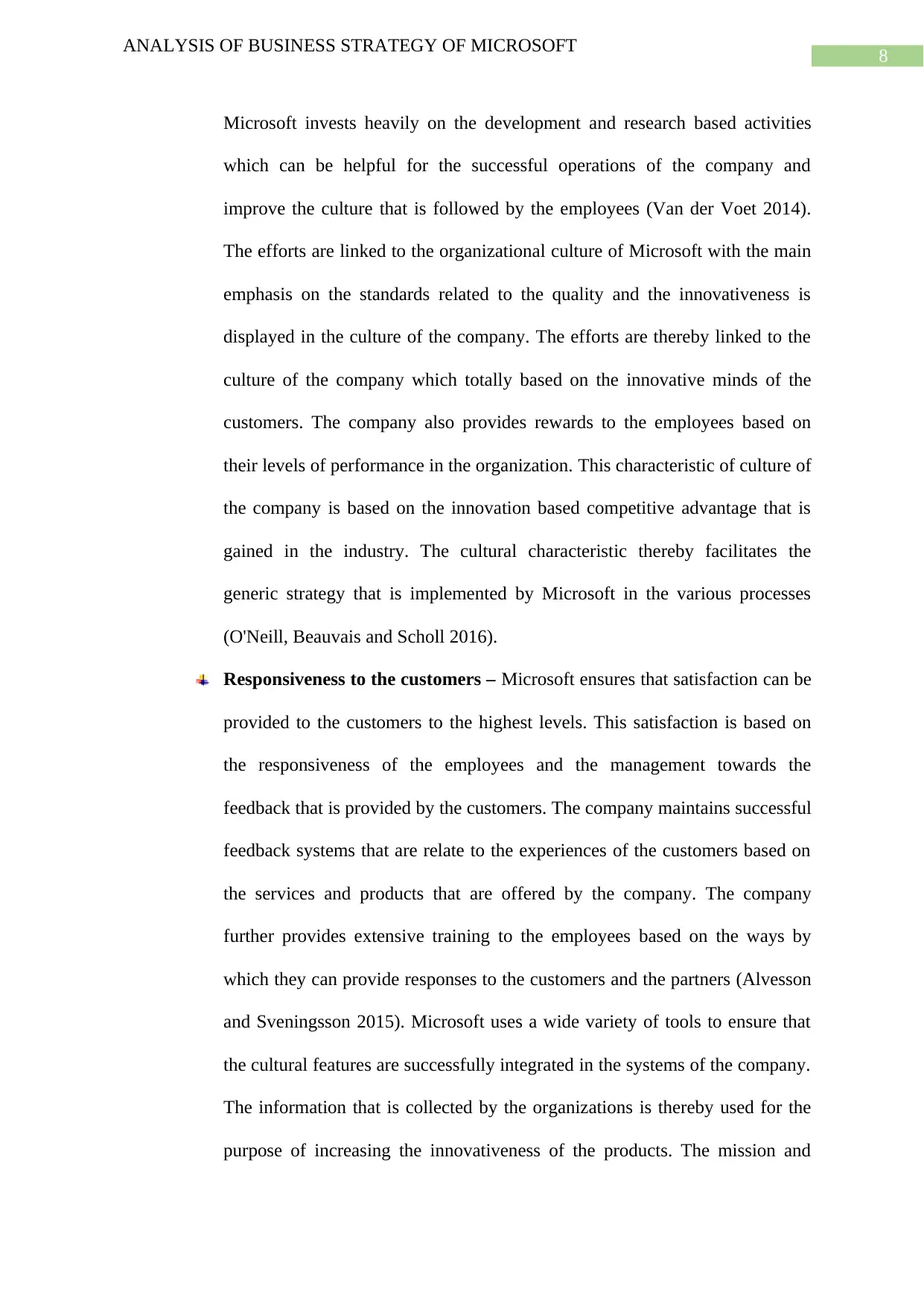
8
ANALYSIS OF BUSINESS STRATEGY OF MICROSOFT
Microsoft invests heavily on the development and research based activities
which can be helpful for the successful operations of the company and
improve the culture that is followed by the employees (Van der Voet 2014).
The efforts are linked to the organizational culture of Microsoft with the main
emphasis on the standards related to the quality and the innovativeness is
displayed in the culture of the company. The efforts are thereby linked to the
culture of the company which totally based on the innovative minds of the
customers. The company also provides rewards to the employees based on
their levels of performance in the organization. This characteristic of culture of
the company is based on the innovation based competitive advantage that is
gained in the industry. The cultural characteristic thereby facilitates the
generic strategy that is implemented by Microsoft in the various processes
(O'Neill, Beauvais and Scholl 2016).
Responsiveness to the customers – Microsoft ensures that satisfaction can be
provided to the customers to the highest levels. This satisfaction is based on
the responsiveness of the employees and the management towards the
feedback that is provided by the customers. The company maintains successful
feedback systems that are relate to the experiences of the customers based on
the services and products that are offered by the company. The company
further provides extensive training to the employees based on the ways by
which they can provide responses to the customers and the partners (Alvesson
and Sveningsson 2015). Microsoft uses a wide variety of tools to ensure that
the cultural features are successfully integrated in the systems of the company.
The information that is collected by the organizations is thereby used for the
purpose of increasing the innovativeness of the products. The mission and
ANALYSIS OF BUSINESS STRATEGY OF MICROSOFT
Microsoft invests heavily on the development and research based activities
which can be helpful for the successful operations of the company and
improve the culture that is followed by the employees (Van der Voet 2014).
The efforts are linked to the organizational culture of Microsoft with the main
emphasis on the standards related to the quality and the innovativeness is
displayed in the culture of the company. The efforts are thereby linked to the
culture of the company which totally based on the innovative minds of the
customers. The company also provides rewards to the employees based on
their levels of performance in the organization. This characteristic of culture of
the company is based on the innovation based competitive advantage that is
gained in the industry. The cultural characteristic thereby facilitates the
generic strategy that is implemented by Microsoft in the various processes
(O'Neill, Beauvais and Scholl 2016).
Responsiveness to the customers – Microsoft ensures that satisfaction can be
provided to the customers to the highest levels. This satisfaction is based on
the responsiveness of the employees and the management towards the
feedback that is provided by the customers. The company maintains successful
feedback systems that are relate to the experiences of the customers based on
the services and products that are offered by the company. The company
further provides extensive training to the employees based on the ways by
which they can provide responses to the customers and the partners (Alvesson
and Sveningsson 2015). Microsoft uses a wide variety of tools to ensure that
the cultural features are successfully integrated in the systems of the company.
The information that is collected by the organizations is thereby used for the
purpose of increasing the innovativeness of the products. The mission and
⊘ This is a preview!⊘
Do you want full access?
Subscribe today to unlock all pages.

Trusted by 1+ million students worldwide
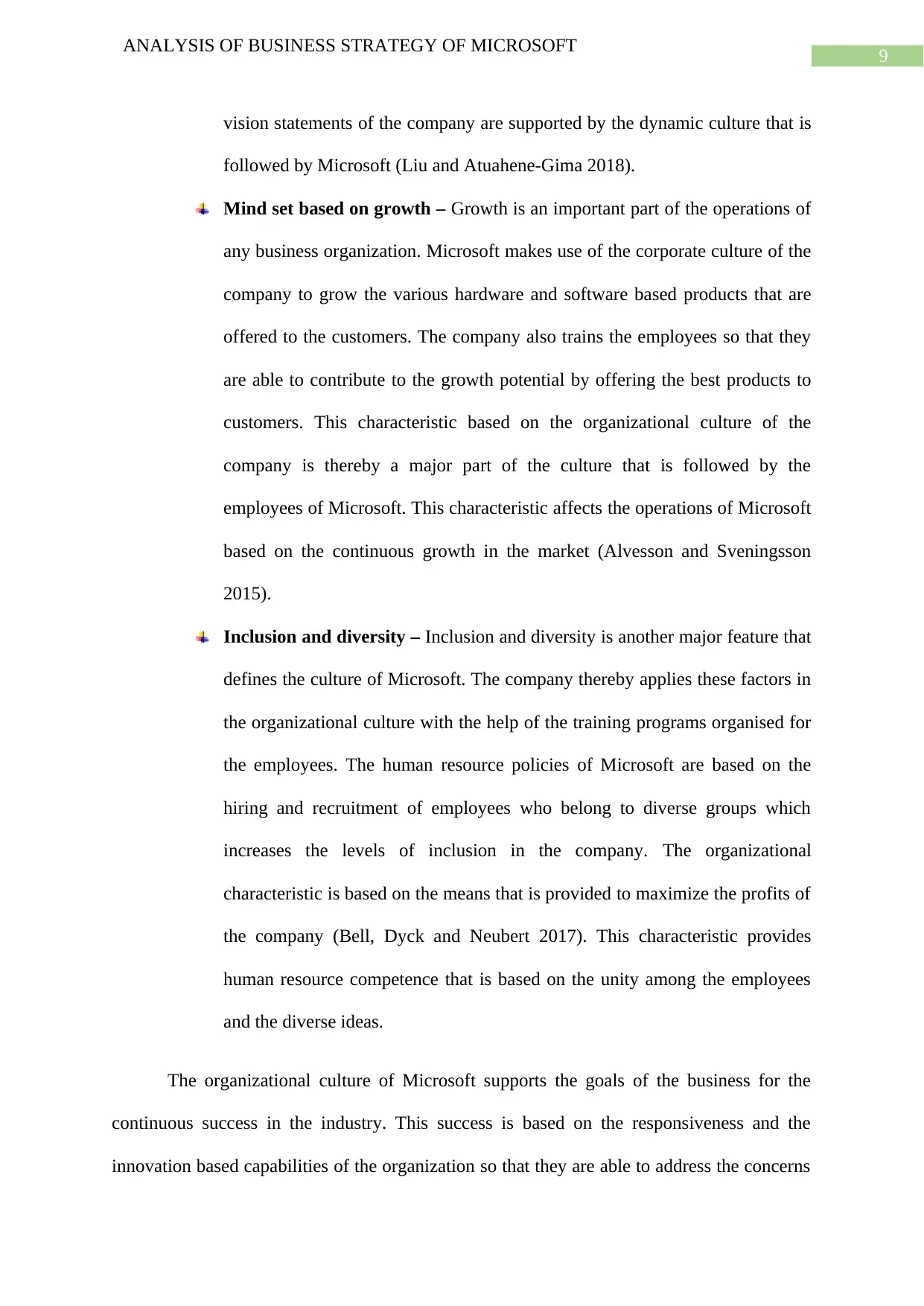
9
ANALYSIS OF BUSINESS STRATEGY OF MICROSOFT
vision statements of the company are supported by the dynamic culture that is
followed by Microsoft (Liu and Atuahene-Gima 2018).
Mind set based on growth – Growth is an important part of the operations of
any business organization. Microsoft makes use of the corporate culture of the
company to grow the various hardware and software based products that are
offered to the customers. The company also trains the employees so that they
are able to contribute to the growth potential by offering the best products to
customers. This characteristic based on the organizational culture of the
company is thereby a major part of the culture that is followed by the
employees of Microsoft. This characteristic affects the operations of Microsoft
based on the continuous growth in the market (Alvesson and Sveningsson
2015).
Inclusion and diversity – Inclusion and diversity is another major feature that
defines the culture of Microsoft. The company thereby applies these factors in
the organizational culture with the help of the training programs organised for
the employees. The human resource policies of Microsoft are based on the
hiring and recruitment of employees who belong to diverse groups which
increases the levels of inclusion in the company. The organizational
characteristic is based on the means that is provided to maximize the profits of
the company (Bell, Dyck and Neubert 2017). This characteristic provides
human resource competence that is based on the unity among the employees
and the diverse ideas.
The organizational culture of Microsoft supports the goals of the business for the
continuous success in the industry. This success is based on the responsiveness and the
innovation based capabilities of the organization so that they are able to address the concerns
ANALYSIS OF BUSINESS STRATEGY OF MICROSOFT
vision statements of the company are supported by the dynamic culture that is
followed by Microsoft (Liu and Atuahene-Gima 2018).
Mind set based on growth – Growth is an important part of the operations of
any business organization. Microsoft makes use of the corporate culture of the
company to grow the various hardware and software based products that are
offered to the customers. The company also trains the employees so that they
are able to contribute to the growth potential by offering the best products to
customers. This characteristic based on the organizational culture of the
company is thereby a major part of the culture that is followed by the
employees of Microsoft. This characteristic affects the operations of Microsoft
based on the continuous growth in the market (Alvesson and Sveningsson
2015).
Inclusion and diversity – Inclusion and diversity is another major feature that
defines the culture of Microsoft. The company thereby applies these factors in
the organizational culture with the help of the training programs organised for
the employees. The human resource policies of Microsoft are based on the
hiring and recruitment of employees who belong to diverse groups which
increases the levels of inclusion in the company. The organizational
characteristic is based on the means that is provided to maximize the profits of
the company (Bell, Dyck and Neubert 2017). This characteristic provides
human resource competence that is based on the unity among the employees
and the diverse ideas.
The organizational culture of Microsoft supports the goals of the business for the
continuous success in the industry. This success is based on the responsiveness and the
innovation based capabilities of the organization so that they are able to address the concerns
Paraphrase This Document
Need a fresh take? Get an instant paraphrase of this document with our AI Paraphraser
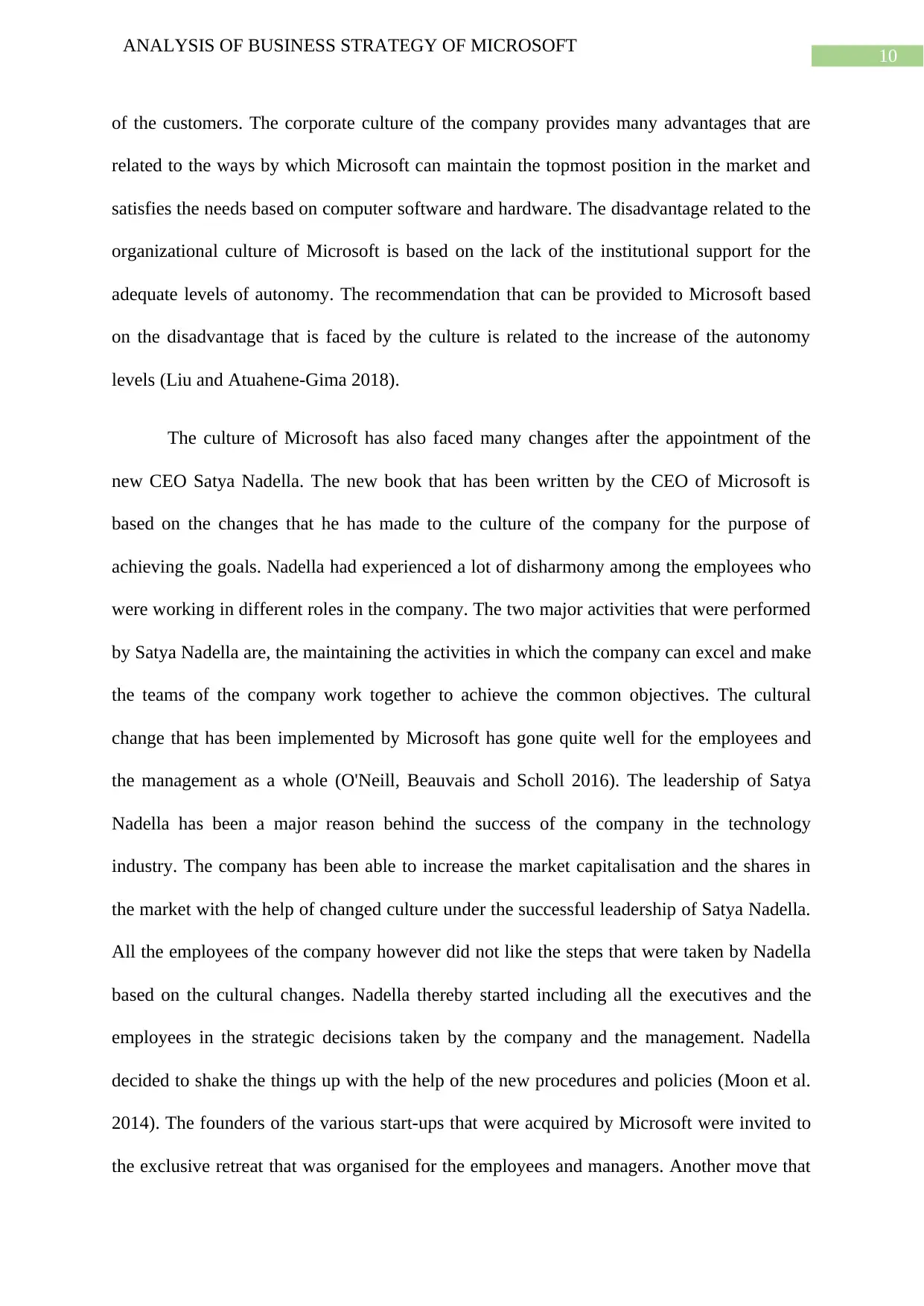
10
ANALYSIS OF BUSINESS STRATEGY OF MICROSOFT
of the customers. The corporate culture of the company provides many advantages that are
related to the ways by which Microsoft can maintain the topmost position in the market and
satisfies the needs based on computer software and hardware. The disadvantage related to the
organizational culture of Microsoft is based on the lack of the institutional support for the
adequate levels of autonomy. The recommendation that can be provided to Microsoft based
on the disadvantage that is faced by the culture is related to the increase of the autonomy
levels (Liu and Atuahene-Gima 2018).
The culture of Microsoft has also faced many changes after the appointment of the
new CEO Satya Nadella. The new book that has been written by the CEO of Microsoft is
based on the changes that he has made to the culture of the company for the purpose of
achieving the goals. Nadella had experienced a lot of disharmony among the employees who
were working in different roles in the company. The two major activities that were performed
by Satya Nadella are, the maintaining the activities in which the company can excel and make
the teams of the company work together to achieve the common objectives. The cultural
change that has been implemented by Microsoft has gone quite well for the employees and
the management as a whole (O'Neill, Beauvais and Scholl 2016). The leadership of Satya
Nadella has been a major reason behind the success of the company in the technology
industry. The company has been able to increase the market capitalisation and the shares in
the market with the help of changed culture under the successful leadership of Satya Nadella.
All the employees of the company however did not like the steps that were taken by Nadella
based on the cultural changes. Nadella thereby started including all the executives and the
employees in the strategic decisions taken by the company and the management. Nadella
decided to shake the things up with the help of the new procedures and policies (Moon et al.
2014). The founders of the various start-ups that were acquired by Microsoft were invited to
the exclusive retreat that was organised for the employees and managers. Another move that
ANALYSIS OF BUSINESS STRATEGY OF MICROSOFT
of the customers. The corporate culture of the company provides many advantages that are
related to the ways by which Microsoft can maintain the topmost position in the market and
satisfies the needs based on computer software and hardware. The disadvantage related to the
organizational culture of Microsoft is based on the lack of the institutional support for the
adequate levels of autonomy. The recommendation that can be provided to Microsoft based
on the disadvantage that is faced by the culture is related to the increase of the autonomy
levels (Liu and Atuahene-Gima 2018).
The culture of Microsoft has also faced many changes after the appointment of the
new CEO Satya Nadella. The new book that has been written by the CEO of Microsoft is
based on the changes that he has made to the culture of the company for the purpose of
achieving the goals. Nadella had experienced a lot of disharmony among the employees who
were working in different roles in the company. The two major activities that were performed
by Satya Nadella are, the maintaining the activities in which the company can excel and make
the teams of the company work together to achieve the common objectives. The cultural
change that has been implemented by Microsoft has gone quite well for the employees and
the management as a whole (O'Neill, Beauvais and Scholl 2016). The leadership of Satya
Nadella has been a major reason behind the success of the company in the technology
industry. The company has been able to increase the market capitalisation and the shares in
the market with the help of changed culture under the successful leadership of Satya Nadella.
All the employees of the company however did not like the steps that were taken by Nadella
based on the cultural changes. Nadella thereby started including all the executives and the
employees in the strategic decisions taken by the company and the management. Nadella
decided to shake the things up with the help of the new procedures and policies (Moon et al.
2014). The founders of the various start-ups that were acquired by Microsoft were invited to
the exclusive retreat that was organised for the employees and managers. Another move that
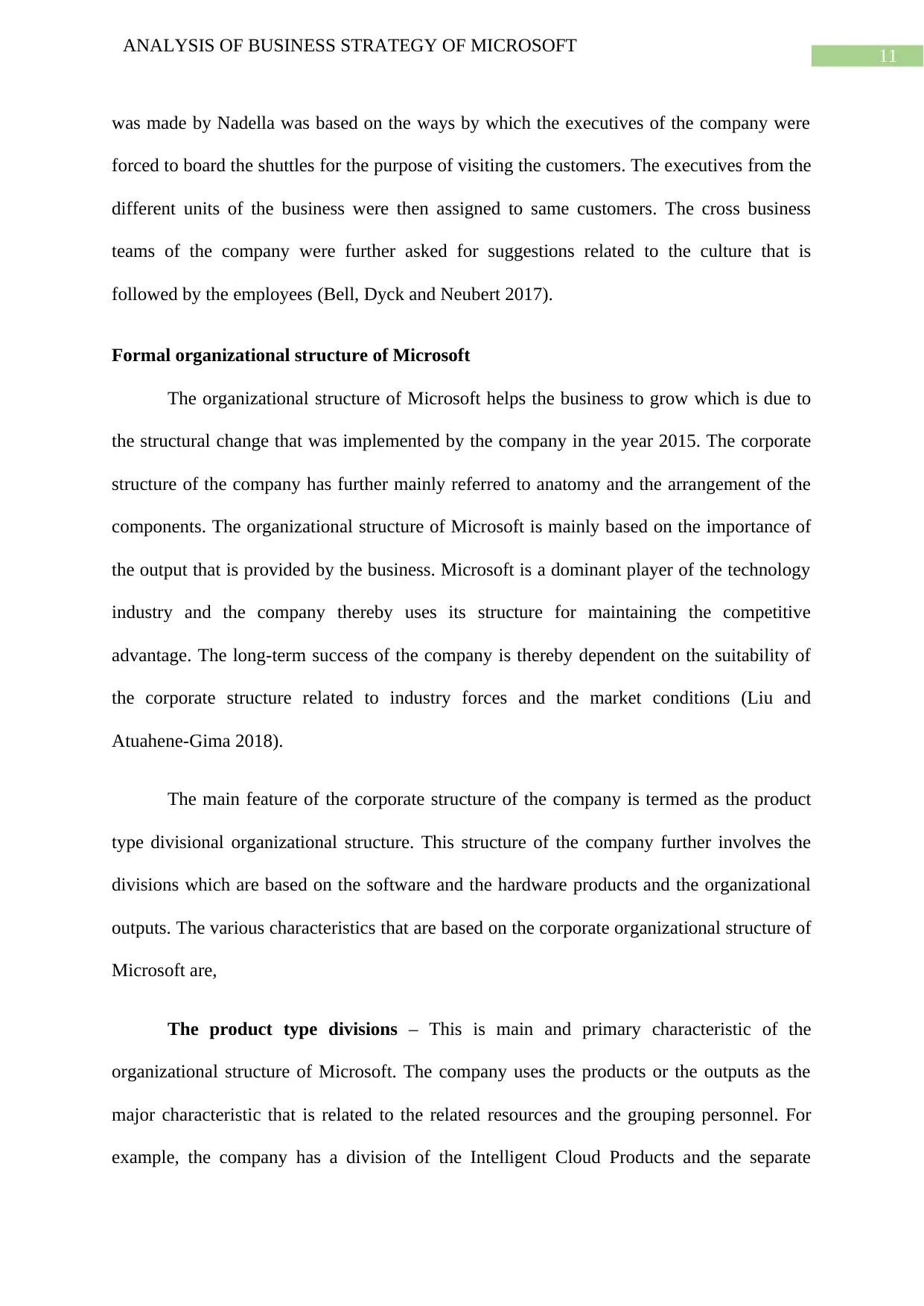
11
ANALYSIS OF BUSINESS STRATEGY OF MICROSOFT
was made by Nadella was based on the ways by which the executives of the company were
forced to board the shuttles for the purpose of visiting the customers. The executives from the
different units of the business were then assigned to same customers. The cross business
teams of the company were further asked for suggestions related to the culture that is
followed by the employees (Bell, Dyck and Neubert 2017).
Formal organizational structure of Microsoft
The organizational structure of Microsoft helps the business to grow which is due to
the structural change that was implemented by the company in the year 2015. The corporate
structure of the company has further mainly referred to anatomy and the arrangement of the
components. The organizational structure of Microsoft is mainly based on the importance of
the output that is provided by the business. Microsoft is a dominant player of the technology
industry and the company thereby uses its structure for maintaining the competitive
advantage. The long-term success of the company is thereby dependent on the suitability of
the corporate structure related to industry forces and the market conditions (Liu and
Atuahene-Gima 2018).
The main feature of the corporate structure of the company is termed as the product
type divisional organizational structure. This structure of the company further involves the
divisions which are based on the software and the hardware products and the organizational
outputs. The various characteristics that are based on the corporate organizational structure of
Microsoft are,
The product type divisions – This is main and primary characteristic of the
organizational structure of Microsoft. The company uses the products or the outputs as the
major characteristic that is related to the related resources and the grouping personnel. For
example, the company has a division of the Intelligent Cloud Products and the separate
ANALYSIS OF BUSINESS STRATEGY OF MICROSOFT
was made by Nadella was based on the ways by which the executives of the company were
forced to board the shuttles for the purpose of visiting the customers. The executives from the
different units of the business were then assigned to same customers. The cross business
teams of the company were further asked for suggestions related to the culture that is
followed by the employees (Bell, Dyck and Neubert 2017).
Formal organizational structure of Microsoft
The organizational structure of Microsoft helps the business to grow which is due to
the structural change that was implemented by the company in the year 2015. The corporate
structure of the company has further mainly referred to anatomy and the arrangement of the
components. The organizational structure of Microsoft is mainly based on the importance of
the output that is provided by the business. Microsoft is a dominant player of the technology
industry and the company thereby uses its structure for maintaining the competitive
advantage. The long-term success of the company is thereby dependent on the suitability of
the corporate structure related to industry forces and the market conditions (Liu and
Atuahene-Gima 2018).
The main feature of the corporate structure of the company is termed as the product
type divisional organizational structure. This structure of the company further involves the
divisions which are based on the software and the hardware products and the organizational
outputs. The various characteristics that are based on the corporate organizational structure of
Microsoft are,
The product type divisions – This is main and primary characteristic of the
organizational structure of Microsoft. The company uses the products or the outputs as the
major characteristic that is related to the related resources and the grouping personnel. For
example, the company has a division of the Intelligent Cloud Products and the separate
⊘ This is a preview!⊘
Do you want full access?
Subscribe today to unlock all pages.

Trusted by 1+ million students worldwide
1 out of 19
Related Documents
Your All-in-One AI-Powered Toolkit for Academic Success.
+13062052269
info@desklib.com
Available 24*7 on WhatsApp / Email
![[object Object]](/_next/static/media/star-bottom.7253800d.svg)
Unlock your academic potential
Copyright © 2020–2025 A2Z Services. All Rights Reserved. Developed and managed by ZUCOL.





